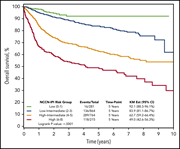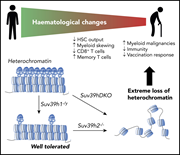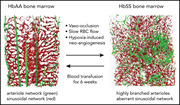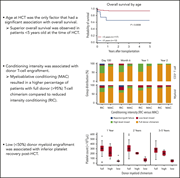Issue Archive
Table of Contents
BLOOD COMMENTARIES
PLENARY PAPER
Evolution of retrovirus-infected premalignant T-cell clones prior to adult T-cell leukemia/lymphoma diagnosis
Clinical Trials & Observations
Fewer than 5% of people with chronic human T-cell leukemia virus type 1 (HTLV-1) infection develop adult T-cell leukemia/lymphoma (ATLL), and the interval between infection and leukemia diagnosis is typically decades. In this Plenary Paper, Rowan and colleagues map the emergence of clones bearing ATLL-associated genomic variants and leukemogenic mutations, revealing the kinetics of evolution of the malignant clone in ATLL and raising the prospect for development of predictive biomarkers of transformation.
PERSPECTIVE
COVID-19 and its implications for thrombosis and anticoagulation
Connors and Levy provide a Perspective on the coagulopathy observed in patients with severe COVID-19, highlighting its pathophysiology and relationship to inflammation and providing practical suggestions for the prevention and management of venous thrombosis in this setting.
CLINICAL TRIALS AND OBSERVATIONS
International prognostic indices in diffuse large B-cell lymphoma: a comparison of IPI, R-IPI, and NCCN-IPI
Clinical Trials & Observations
Ruppert and colleagues provide a comparison of 3 validated prognostic indices for patients with newly diagnosed diffuse large B-cell lymphoma, using data from 7 major trials and 2124 patients. They identified a shortcoming common to all: discrimination of patients with very poor prognosis.
Foreseeing what is to happen in DLBCL
Clinical Trials & Observations
HEMATOPOIESIS AND STEM CELLS
Extreme disruption of heterochromatin is required for accelerated hematopoietic aging
Loss of heterochromatin is postulated as a universal mechanism of aging across cell types. However, Keenan and colleagues revealed that murine hematopoiesis is remarkably tolerant of severe heterochromatin disruption, in part due to redundancy between 2 Suv39h enzymes in the protection of hematopoietic stem cells from accelerated aging.
MYELOID NEOPLASIA
Site-specific methylation of 18S ribosomal RNA by SNORD42A is required for acute myeloid leukemia cell proliferation
Small nucleolar RNAs (snoRNAs) are noncoding RNAs that may play important roles in leukemogenesis. Using snoRNA-focused CRISPR-Cas9 knockout library screens, Pauli and colleagues revealed SNORD42A to be an essential modulator of ribosomal protein translation and acute myeloid leukemia cell survival and proliferation.
RED CELLS, IRON, AND ERYTHROPOIESIS
Pathologic angiogenesis in the bone marrow of humanized sickle cell mice is reversed by blood transfusion
Utilizing a murine model of sickle cell disease (SCD), Park et al identified that SCD induces a disorganized and structurally abnormal vascular network in the bone marrow and dysfunctional vascular niche. These pathological changes are rapidly reversible with a regular transfusion regimen that could potentially be translated to human SCD patients.
THROMBOSIS AND HEMOSTASIS
FcRn augments induction of tissue factor activity by IgG-containing immune complexes
Cines and colleagues describe how the neonatal immunoglobulin G (IgG) Fc receptor (FcRn) participates in the induction of tissue factor activity by IgG-containing immune complexes. Their cell line and in vivo model data suggest that inhibition of FcRn may reduce the prothrombotic phenotype of patients with disorders mediated by IgG-containing immune complexes, such as warm autoimmune hemolytic anemia.
TRANSPLANTATION
Excellent outcomes following hematopoietic cell transplantation for Wiskott-Aldrich syndrome: a PIDTC report
Clinical Trials & Observations
Wiskott-Aldrich syndrome (WAS) is an X-linked disease manifesting with thrombocytopenia, eczema, recurrent infections, autoimmune disease, and malignancy. Hematopoietic cell transplantation (HCT) is potentially curative. Burroughs and coauthors from the Primary Immune Deficiency Treatment Consortium (PIDTC) report excellent outcomes for WAS patients with modern allogeneic HCT and high-level myeloid engraftment.
LETTER TO BLOOD
Outcomes of older patients in ZUMA-1, a pivotal study of axicabtagene ciloleucel in refractory large B-cell lymphoma
Clinical Trials & Observations
Neelapu and colleagues report a post hoc subgroup analysis from the ZUMA-1 trial of chimeric antigen receptor T-cell therapy for relapsed or refractory diffuse large B cell lymphoma. In comparison with younger patients, those ≥65 years old have similar rates of complete response and durable response at 2 years, but higher rates of neurological toxicity.
BLOOD WORK
ERRATUM
-
Cover Image
Cover Image
![issue cover]()
Bone marrow cavity of a humanized sickle cell mouse showing widespread pathologic angiogenesis (arteries and arterioles in green; sinusoids in red) in response to slow red blood cell flow and vaso-occlusions. The distorted neovascular network is completely reversed by a 6-week blood transfusion regimen. See the article by Park et al on page 2071.
- PDF Icon Front MatterFront Matter
- PDF Icon Table of ContentsTable of Contents
- PDF Icon Back MatterBack Matter
- PDF Icon Editorial BoardEditorial Board
Advertisement intended for health care professionals
Email alerts
Advertisement intended for health care professionals










Predicting the future: adult T-cell leukemia